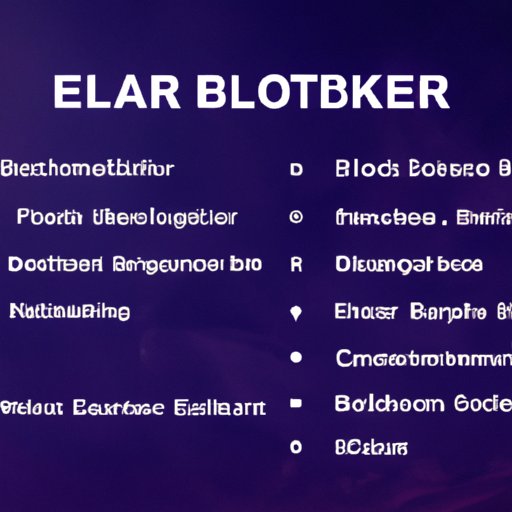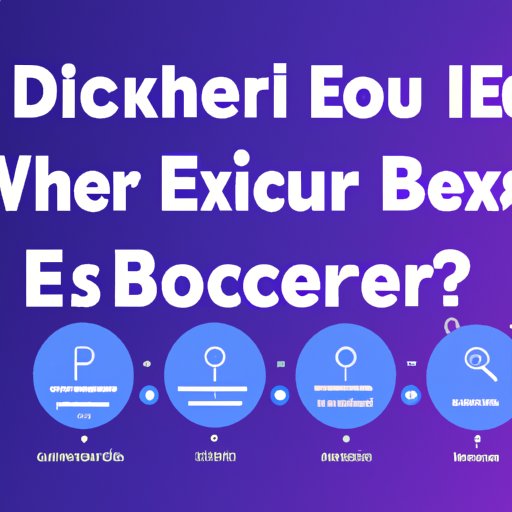Introduction
A blockchain explorer is a powerful tool that allows users to monitor their transactions and other activities on a blockchain network. It is an essential component of any blockchain system, as it enables users to track the progress of their transactions, view the details of each transaction, and access data stored on the blockchain. In this article, we will explore how to create a blockchain explorer.
Overview of What a Blockchain Explorer Is
A blockchain explorer is a user interface that allows users to search, view, and analyze data stored on a blockchain. It provides users with a detailed overview of the entire blockchain network, including all blocks, transactions, and other associated data. The blockchain explorer also allows users to monitor their transactions and other activities on the blockchain in real time.
Benefits of Creating a Blockchain Explorer
Creating a blockchain explorer has several benefits, including:
- Provide users with an easy way to track and monitor their transactions on the blockchain.
- Allow users to view the details of each transaction on the blockchain.
- Provide users with an overview of the entire blockchain network.
- Enable users to access data stored on the blockchain.
- Allow users to detect fraudulent activities on the blockchain.
Step-by-Step Guide to Building a Blockchain Explorer
Building a blockchain explorer can be a complex and challenging process. However, it is possible to create a functional and secure blockchain explorer if you follow the right steps. Here is a step-by-step guide to building a blockchain explorer:
Gathering the Necessary Components
The first step in building a blockchain explorer is to gather the necessary components. You will need a web server, a database, and a programming language such as JavaScript or Python. You may also need additional components, depending on the specific features you want to include in your blockchain explorer.
Setting Up the Environment
Once you have gathered the necessary components, you need to set up the environment for your blockchain explorer. This involves configuring the web server, setting up the database, and installing the necessary programming language. Once the environment is set up, you can begin to develop the blockchain explorer.
Developing the Blockchain Explorer
The next step is to develop the blockchain explorer. This involves writing the code that will power the blockchain explorer. You will need to write code to query the blockchain, retrieve data, and display it in a user-friendly format. Once the code is written, you can then deploy the blockchain explorer.
A Beginner’s Guide to Developing a Blockchain Explorer
If you are new to developing a blockchain explorer, there are some important concepts you need to understand. Here is a beginner’s guide to developing a blockchain explorer:
Introduction to Developing a Blockchain Explorer
Before you start developing a blockchain explorer, it is important to understand the basics of blockchain technology. You should also familiarize yourself with the different types of blockchains and their respective features. This will help you determine which type of blockchain is best suited for your needs.
Understanding the Basics of Programming Languages
In order to develop a blockchain explorer, you must have a good understanding of programming languages such as JavaScript or Python. You should also become familiar with the various libraries and frameworks available for developing blockchain applications. This will enable you to write the necessary code to power your blockchain explorer.
What You Need to Know Before Starting
Before you begin developing a blockchain explorer, it is important to understand the different components that make up a blockchain system. This includes the consensus mechanism, the cryptographic algorithms, and the distributed ledger technology. Knowing these components will help you ensure that your blockchain explorer is secure and reliable.

Overview of the Necessary Components to Build a Blockchain Explorer
Once you have a basic understanding of the components that make up a blockchain system, you can begin to assemble the necessary components to build a blockchain explorer. Here is an overview of the necessary components to build a blockchain explorer:
Platform and Software Requirements
You will need to select a platform and software to develop your blockchain explorer. The most popular platforms for developing blockchain applications include Ethereum, Hyperledger Fabric, and Corda. You will also need to select a programming language, such as JavaScript or Python, as well as any necessary libraries and frameworks.
Hardware Requirements
In addition to the platform and software requirements, you will also need to select the necessary hardware to run your blockchain explorer. This includes servers, storage devices, and networking equipment. You may also need to purchase additional hardware, such as graphics processing units (GPUs) for mining operations.

What You Need to Know Before Setting Up a Blockchain Explorer
Before you set up your blockchain explorer, there are some important considerations you need to make. Here are some of the best practices for setting up a blockchain explorer:
Best Practices for Security
Security is an important consideration when setting up a blockchain explorer. You should implement the latest security protocols, such as two-factor authentication and encryption, to protect your blockchain explorer from malicious attacks. You should also regularly update the software and hardware components of your blockchain explorer to ensure that it remains secure.
Guidelines for Deployment
Once you have set up your blockchain explorer, you need to deploy it. This involves connecting it to the blockchain network and making it available for use. You should also ensure that you have proper backup and recovery procedures in place in case something goes wrong during the deployment process.

Implementing the Latest Technologies to Create a Blockchain Explorer
To create a powerful and secure blockchain explorer, you should consider implementing the latest technologies. Here are some of the technologies you should consider incorporating into your blockchain explorer:
Integrating APIs for Data Retrieval
You can integrate APIs into your blockchain explorer to allow users to easily access data stored on the blockchain. This will enable users to quickly and conveniently retrieve data without having to manually search through the blockchain. Additionally, APIs can be used to securely transfer data between different applications.
Using Smart Contracts for Automation
Smart contracts are programs that are stored on the blockchain and execute automatically when certain conditions are met. They can be used to automate certain processes within your blockchain explorer, such as sending notifications or executing transactions. This will enable your blockchain explorer to be more efficient and secure.
Conclusion
Creating a blockchain explorer can be a complex and challenging process. However, by following the right steps and implementing the latest technologies, you can create a powerful and secure blockchain explorer. A blockchain explorer can provide users with an easy way to track and monitor their transactions, view the details of each transaction, and access data stored on the blockchain. By creating a blockchain explorer, you can ensure that users have a secure and reliable way to interact with the blockchain.
Summary of Benefits of Creating a Blockchain Explorer
Creating a blockchain explorer has several benefits, including providing users with an easy way to track and monitor their transactions, viewing the details of each transaction, and accessing data stored on the blockchain. Additionally, a blockchain explorer can help users detect fraudulent activities on the blockchain.
Tips for Successful Creation of a Blockchain Explorer
To successfully create a blockchain explorer, you should gather the necessary components, set up the environment, and develop the blockchain explorer. You should also understand the basics of blockchain technology and programming languages, select the necessary hardware, and implement the latest technologies, such as APIs and smart contracts. Additionally, you should ensure that you have proper security measures in place and guidelines for deployment.
(Note: Is this article not meeting your expectations? Do you have knowledge or insights to share? Unlock new opportunities and expand your reach by joining our authors team. Click Registration to join us and share your expertise with our readers.)
